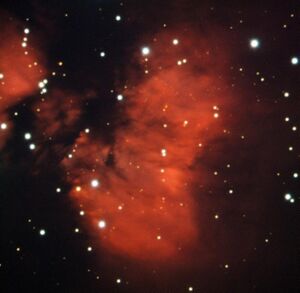Astronomy:RCW 88
Coordinates: ![]() 15h 07m 08s, −57° 48.3′ 0″
15h 07m 08s, −57° 48.3′ 0″
| Nebula | |
|---|---|
 Star-forming region RCW 88 taken with the EFOSC2 instrument on ESO’s New Technology Telescope.[1] | |
| Observation data: J2000 epoch | |
| Right ascension | 15h 07m 08s[2] |
| Declination | −57° 48.3′ 0″[2] |
| Distance | 10.000 ly |
| Apparent magnitude (V) | 12.0 |
| Apparent dimensions (V) | c. 5'-6' |
| Constellation | Circinus |
| Physical characteristics | |
| Radius | c.16±3 ly |
| Designations | PK 320+00.2, WRAY 16-166, WRAY 16-167, PN ARO 527,[2] ARO 146[3] |
RCW 88 is an emission nebula in the southern constellation of Circinus that first appeared in the 1960 astronomical catalogue by Rodgers, Campbell & Whiteoak (RCW) of Hα-emission regions within the southern Milky Way.[4] Earlier observers, like James Wray in 1966, misclassified this as a likely 12.0v magnitude planetary nebula,[5] but later spectroscopic investigations revealed this as a diffuse nebulae.[6] RCW 88 was then to be identified by the infrared satellite IRAS as an HII region.
Deep red images reveal that the inner nebula is divided into two parts by a central dark lane, and there is evidence of a larger halo of fainter nebulosity extending perhaps out to 10 arcmin. The RCW catalogue states the Hα image size is 3'×2.[4]
RCW 88 is located about 3300 parsecs (10,000 light years)[1] from us, though other estimates place this at a closer 1800±300 pc.[7] or 1800±200 pc.[8] Assuming the former distance and the diameter as 5'-6' across, finds by simple trigonometry the true size subtends a minimum of 5±1 parsecs (16±3 light-years.) This small emission nebula shows a mean radial velocity of −18 km.s−1,[7] and is also a faint radio source that was identified by Lloyd Higgs in 1971.[3] Due to the large distance from us, astronomers have made few studies into the nature of RCW 88.
Field Star
There is a 10.8v magnitude star identified as TYC 8702-56-1 positioned at RA : 15h 07m 25.1s Dec. : –57° 48' 32" (2000),[9] place 137 arc seconds southwest of the centre of the bright nebulosity.[10] It is unlikely that this star is associated with the nebulosity being probably a field star.
References
- ↑ 1.0 1.1 "Red Cocoon Harbours Young Stars". ESO Picture of the Week. http://www.eso.org/public/images/potw1231a/. Retrieved 30 July 2012.
- ↑ 2.0 2.1 2.2 "Search results for RCW 88". Astronomical Database. SIMBAD. http://simbad.u-strasbg.fr/simbad/sim-id?Ident=RCW+88. Retrieved 25 February 2017.
- ↑ 3.0 3.1 Higgs, L.A. (1971). "Catalog of radio observations of planetary nebulae, related optical data.". Publications of the Astrophysics Branch 1: 1. Bibcode: 1971PAB.....1....1H.
- ↑ 4.0 4.1 Rodgers, A. W.; Campbell, C. T.; Whiteoak, J. B. (1960), "A catalogue of Hα-emission regions in the southern Milky Way", Monthly Notices of the Royal Astronomical Society 121 (1): 103–110, doi:10.1093/mnras/121.1.103, Bibcode: 1960MNRAS.121..103R
- ↑ Wray, J.D. (25 February 2017). A Study of Hα-emission Objects in the Southern Milky Way. Bibcode: 1966PhDT.........3W. http://cdsads.u-strasbg.fr/cgi-bin/nph-bib_query?1966PhDT.........3W&db_key=AST&nosetcookie=1.
- ↑ Acker, A.; Chopinet, M.; Pottasch, S.R.; Stenholm, B. (1987). "Misclassified planetary nebula". Astronomy and Astrophysics Supplement Series 71 (1): 163–175. Bibcode: 1987A&AS...71..163A.
- ↑ 7.0 7.1 Avedisova, V.S.; Palous, J. (1989). "Kinematics of star forming regions". Bulletin Astronomical Institutes of Czechoslovakia 40 (1): 42–52. Bibcode: 1989BAICz..40...42A.
- ↑ Avedisova, V.S.; Kondratenko, G.I. (1984). "Exciting stars and the distances of the diffuse nebulae". Nauchnye Informatsii 56: 49. Bibcode: 1984NInfo..56...59A.
- ↑ "Search results for TYC 870-56-1 88". Astronomical Database. SIMBAD. http://simbad.u-strasbg.fr/simbad/sim-id?Ident=%407688161&Name=TYC%208702-56-1&submit=submit. Retrieved 25 February 2017.
- ↑ "Search results for TYC 870-56-1 88". Astronomical Database. SIMBAD. http://simbad.u-strasbg.fr/simbad/sim-coo?Coord=15+07+08-57+48.3&CooFrame=ICRS&CooEqui=2000.0&CooEpoch=J2000&Radius.unit=arcmin&submit=query+around&Radius=3. Retrieved 25 February 2017.
 |

